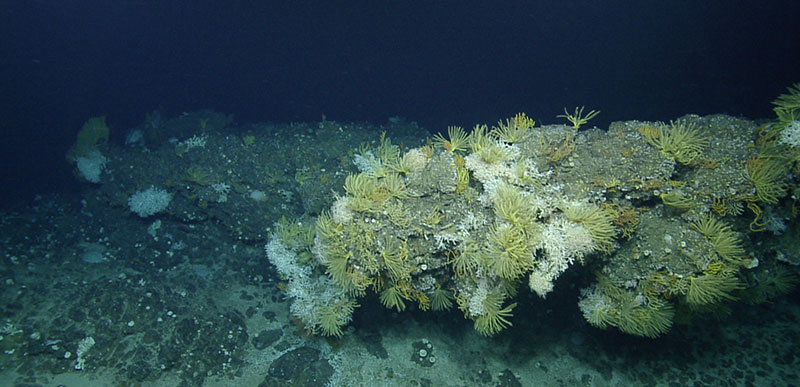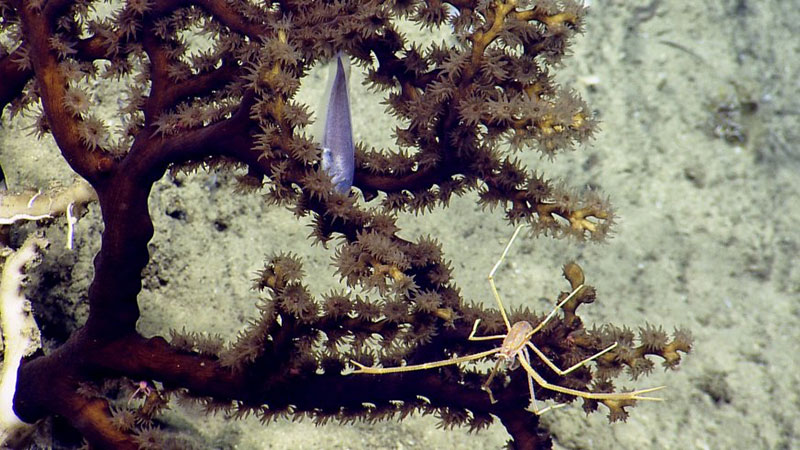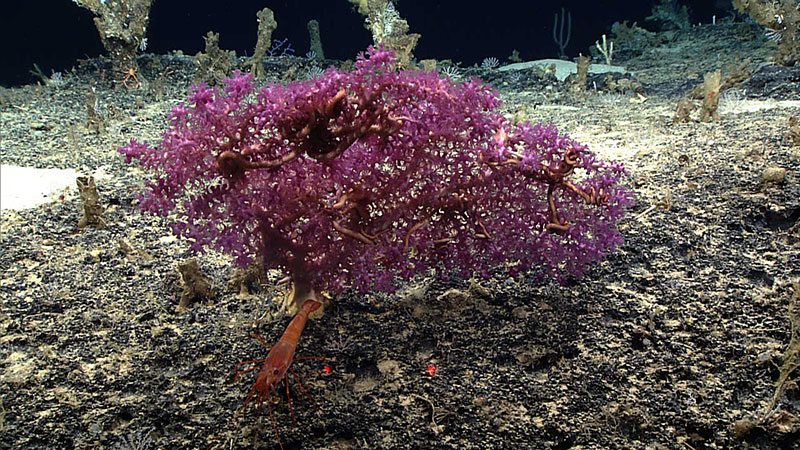
by Steven Auscavitch, Temple University

Seamount summit coral community from the Anegada Passage area. Rocky, reef-like assemblages covered with hard corals (Madracis sp. and Madrepora sp.) often find abundant hard substrate on current-swept seamount summits. Image courtesy of the Ocean Exploration Trust. Download image (jpg, 1.4 MB).
The Caribbean Sea engenders images of colorful shallow-water coral reefs teeming with fish and invertebrate life. The diversity of benthic megafauna (organisms larger than about two centimeters, or one inch, in size) in these ecosystems is immense and well understood compared to their deepwater counterparts. The foundation organisms for many of these environments are the corals themselves; the same is true in the deep sea. This essay will summarize some of the biodiversity highlights of deepwater corals that are known in the U.S. Caribbean and surrounding waters.
Like shallow-water corals, deep-sea corals take on numerous forms and functions. The major groups of deepwater corals we will likely encounter on this expedition are scleractinians (hard or stony corals), sea fans and whips (soft corals or octocorals), antipatharians (black corals), and stylasterid hydrocorals (lace corals). Many species from the first two groups can be found in shallow-water reefs as well, but few people are aware that soft corals actually have a greater diversity in the deep sea. The latter groups tend to be more common at deeper, mesophotic and bathyal depths. Stylasterids are known to be sensitive to sediment accumulation on the seafloor and are more likely to be found further from shorelines.

A hard coral (Dendrophyllia sp.) from the area around Navassa Island in the U.S. Caribbean. Deepwater corals provide habitat for associated species like fishes and invertebrates. Image courtesy of the Ocean Exploration Trust. Download image (jpg, 334 KB).
Biologists have been studying the diversity of corals collected from the deep sea in the Caribbean region since the late 19th century, but discoveries are infrequent and often rely on reanalyzing old data sets or examining past collections. For example, it isn’t yet well known how Caribbean deepwater coral species compare to the fauna of the surrounding waters, like the North Atlantic Ocean or Gulf of Mexico. Data that has been collected to date is geographically and bathymetrically sparse. Knowing which species occur in an area is important for understanding how populations of species are connected, information which is important to develop effective marine management strategies.
From past work, peaks in deepwater coral diversity have been encountered around Puerto Rico and the U.S. Virgin Islands at depths ranging between 200-350 meters (~650-1000 feet). However, we still have a lot to learn about deepwater coral diversity below these depths.

Diverse deep-sea coral assemblage imaged south of St. Croix at a depth of ~900 meters (~2,950 feet) during the 2015 Océano Profundo expedition aboard NOAA Ship Okeanos Explorer. Image courtesy of the NOAA Office of Ocean Exploration and Research, Exploring Puerto Rico’s Seamounts, Trenches, and Troughs. Download image (jpg, 1.7 MB).
Some of the most recent work exploring deepwater ecosystems in the Caribbean was conducted in 2013 and 2014 on Exploration Vessel (E/V) Nautilus and in 2015 on NOAA Ship Okeanos Explorer. In 2013 and 2014, scientists on E/V Nautilus examined the diversity of deepwater corals on three seamounts in the Anegada Passage, east of the U.S. and British Virgin Islands. These seamounts were found to have a high diversity of deepwater black coral and soft coral species down to a depth of 2,000 meters (~6,500 feet). The seamount summit communities between 200 and 300 meters varied between seamounts, but were observed to have relatively dense clusters of deepwater corals and sponges compared to deeper depths.
Over the course of the 2015 Océano Profundo expedition to the U.S. Caribbean, some 50 different species of deepwater corals were identified from depths up to 3,000 meters (~10,000 feet). The most diverse coral site on that expedition was on the south of St. Croix between depths of 830-930 meters (~3,000 feet). During the present 2018 Océano Profundo expedition, we will be utilizing both video records and targeted collections to better understand how much coral diversity occurs at depths below 500 meters (~1500 feet).

Diverse deep-sea coral assemblage imaged south of St. Croix at a depth of ~900 meters (~2,950 feet) during the 2015 Océano Profundo expedition aboard NOAA Ship Okeanos Explorer. Image courtesy of the NOAA Office of Ocean Exploration and Research, Exploring Puerto Rico’s Seamounts, Trenches, and Troughs. Download image (jpg, 1.4 MB).
Where we look for deepwater corals has a lot to do with the shape and roughness of the seafloor. Mapping operations can provide important insights into these seafloor variables, and thereby help us locate areas where we might find abundant and diverse deepwater coral communities. This is because many corals require a firm substrate to attach to the seafloor and are also typically found in areas with complex seafloor topographies like seamounts or submarine canyons.
Seamount summits may have higher diversities or higher densities of corals, as their communities are composed of both deep and mesophotic species (200-300 meters). This may occur because of overlapping species depth ranges and enhanced food supply. Submarine canyons can also be hotspots for deepwater coral abundance and diversity. Canyons usually occur adjacent to large landmasses, continents, or islands, and channel sediments and materials into the deep sea. They can also bring nutrient-rich waters up to shallower depths driving biological productivity.
During the 2018 Océano Profundo expedition, we will explore several seamounts, submarine canyons, and other seafloor features where we expect to find a high abundance of corals. We hope you can join us as we explore these important, yet poorly known, deep-sea habitats.